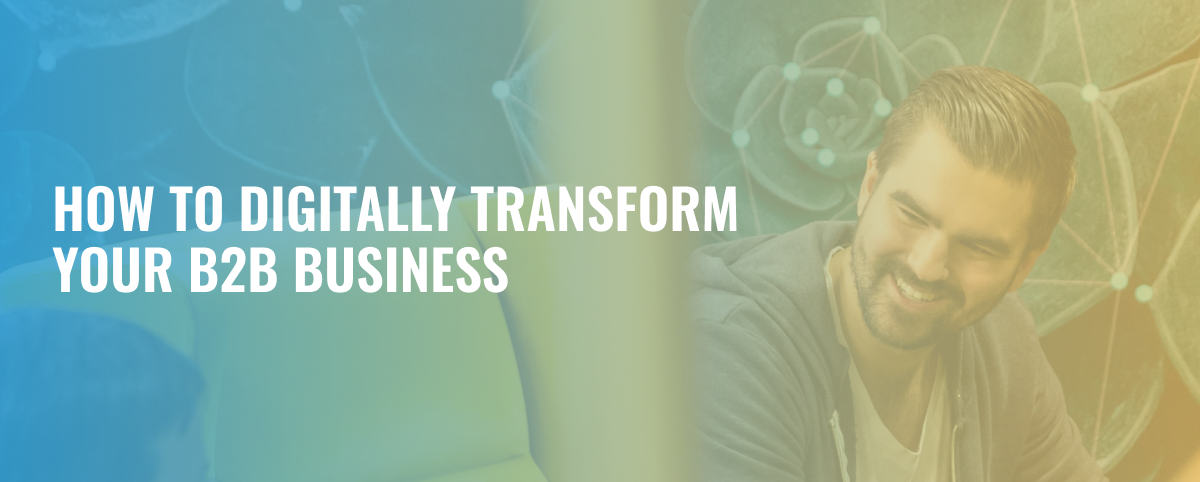8 minute read
Maximizing Ecommerce Technology: How to Digitally Transform Your B2B Business

A successful digital transformation not only streamlines business processes but also boosts sales and revenue. As B2B buyer behaviors and expectations continue to evolve, the rise of new technologies also isn’t slowing down. More than ever before, businesses now have the opportunity to innovate faster and accelerate their store launch online with all the core B2B features and functionality they need to transition from offline to online and better serve their target audiences. Selecting the right eCommerce technology and delivering excellent customer experiences is the key to B2B success.
UNDERSTANDING THE STATE OF B2B ECOMMERCE
B2B eCommerce has been on the rise over the years as more and more companies have been looking to adopt digital platforms and solutions in order to replace traditional, manual processes. Further accelerated by the COVID-19 pandemic, this rise has continued as B2B businesses have seen the benefits of a B2B eCommerce solution including improved efficiency, reduced overhead costs, and the ability to enter into previously untapped markets.
While there are often more complexities involved when it comes to B2B transactions in comparison to B2C, B2B buyers still demand consumer-like experiences. Automation tools and the ability to integrate with other business systems have become key components for B2B eCommerce. Selection of a suitable eCommerce platform also takes into consideration the ability to handle functionality such as bulk ordering, showcasing customer-specific pricing, and invoice management.
CHALLENGES B2B BUSINESSES FACE WITH THEIR ECOMMERCE TECH STACK
From integration with various enterprise systems to complexities in B2B business workflows, there are many factors and challenges B2B businesses take into account in regards to successfully selecting and managing their eCommerce tech stack. When it comes to evaluating an eCommerce platform and solution, here are some of the challenges involved.
-
INTEGRATION WITH EXISTING SYSTEMS
62% of business executives have stated they’ve experienced roadblocks when it comes to integrating their eCommerce tech stack with existing systems (Gatepoint Research). Real-time data is important for businesses to maintain accurate pricing, inventory, and order fulfillment. Without proper integration, this can lead to issues with data synchronization across the business as well as the possibility of overselling products or delays in delivery times.
-
TECHNOLOGY ARCHITECTURE ALIGNMENT
B2B businesses require a technology architecture that meets their specific needs and supports their business practices such as being able to handle bulk ordering and complex pricing structures. As the business grows, the eCommerce platform also needs to scale with it, allowing for larger transaction volumes, increased traffic, and the ability to adapt to future features and functionality, all without compromising performance.
-
DIGITAL TRANSFORMATION SUPPORT
Digital transformation involves more than just the technology itself. It also involves buy-in from key stakeholders and members of the business. When transitioning from a legacy system to a modern solution, it requires expert planning and execution to ensure business operations remain uninterrupted while working towards improving business processes and enhancing customer experiences.
TOP ECOMMERCE GOALS FOR B2B BUSINESSES
Successful B2B businesses continue to redefine their eCommerce strategies as the digital landscape evolves in order to drive growth and stay competitive in their market. Over 70% of business executives surveyed placed strong emphasis on engaging with customers and delivering an improved and personalized customer experience as the top eCommerce goal for their business (Gatepoint Research). Focus on the customer remains at the forefront of any eCommerce solution.
-
IMPROVE CUSTOMER EXPERIENCE, PERSONALIZATION, AND ENGAGEMENT
B2B buyers look for the same seamless and personalized experience they’ve come to expect from their B2C buying experiences. To meet these high customer expectations, B2B businesses need to offer personalized pricing as well as tailored content while ensuring that the path to purchase for the customer is easy and painless. Engaging with customers at various touchpoints, whether it’s through targeted campaigns or personalized product recommendations can help to further increase loyalty and establish stronger customer relationships.
-
STREAMLINE BUSINESS OPERATIONS
From automating business processes to offering self-service capabilities to customers, efficiency is a key part of a successful B2B eCommerce initiative. From cost reduction to minimizing errors, the move towards digitization and improved operations leads to more reliable service and more satisfaction from customers.
-
MODERNIZE DIGITAL TRANSFORMATION STRATEGY
More than ever, businesses need to be able to adapt to changes in the market and meet customer needs with a commerce platform that can adapt along with them. Whether it’s upgrading from an old legacy system or embracing new technologies, B2B businesses need a modernized digital strategy in order to stay competitive.
-
ALIGN INVESTMENTS WITH BUSINESS OBJECTIVES
Whether the goal is to reach new target markets and increase sales or improve internal operations and operational efficiency, it is important to clearly define objectives. By aligning technology investments with desired business goals, this ensures that every investment into the eCommerce stack delivers tangible value and maximizes use of every aspect of the budget.
-
STAY AHEAD OF EMERGING TRENDS
The eCommerce landscape continues to grow and change at a rapid pace in accordance with new trends and technologies. From adopting new tools to exploring new sales channels, proactively embracing innovation gives businesses an edge in being at the forefront of their industry and continuing to meet changing customer demands.
EVALUATING NEW ECOMMERCE TECHNOLOGY AND PLATFORMS
Choosing the eCommerce platform that’s the best fit for your business needs is an important step as B2B businesses are looking to optimize their online presence. Selecting the right technology is more than simply thinking about serving customers today but also looking ahead for the ability to continue to scale your business in the future.
-
ENTERPRISE B2B AND B2C FUNCTIONALITY
When considering different eCommerce platforms, it is important for B2B businesses to select a solution that offers comprehensive functionality for both B2B and B2C, particularly if the business serves multiple audiences and customer types. For example, a modern SaaS eCommerce platform like BigCommerce offers robust security, lower total cost of ownership, and key B2B and B2C features and functionality that can handle complex B2B processes and streamlined B2C purchases while delivering personalized shopping experiences.
-
MULTI-STOREFRONT AND LOCALIZATION
As you look to take your brand globally and sell cross-border, having an eCommerce platform that can support separate storefronts per region and allow you to customize settings for local currencies and content is crucial. To best deliver personalized and localized shopping experiences to customers in their respective regions, it is important to consider different factors such as the ability to pay in local currency and offering content in the region’s local language.
-
BACK-OFFICE INTEGRATIONS
Systems integration is a key component to making sure that operations like inventory management and order fulfillment run smoothly and data is accurate across all business systems. Whether you’re looking to integrate an ERP, CRM, PIM, or other back-office system, working closely with an experienced agency who understands how to connect both your business systems and eCommerce store is key to creating a unified commerce experience with up-to-date product, order, customer and inventory information among systems.
-
FRICTIONLESS CHECKOUT OPTIONS
Offering a smooth checkout experience is an important factor to minimize friction for customers and generate more conversions. Working with an eCommerce platform that allows customers to checkout on their preferred devices, properly account for negotiated payment methods with the business and quickly access their approved billing and shipping addresses leads to a more streamlined purchasing experience.
STEPS TO A SUCCESSFUL DIGITAL TRANSFORMATION
For any B2B business to best maximize their eCommerce technology and successfully drive digital transformation and growth within their organization, it is important to clearly define business needs and push forward initiatives that are meant to improve revenue and sales while streamlining business processes.
-
UNDERSTANDING YOUR B2B BUSINESS OBJECTIVES
Digital transformation is more than just deciding to onboard a new system. It’s about making sure the business is working with the right eCommerce platform and agency who understands the businesses objectives and can deliver the optimal solution to help the organization achieve its desired business goals.
-
CHOOSING THE RIGHT PLATFORM FOR YOUR ECOMMERCE GOALS
When evaluating your eCommerce options, look for a platform that both gives you both the scalability and flexibility to customize faster and grow more sales while also equipping your business with essential back office integrations and B2B functionality that your business needs to successfully launch your business online with a high-functioning and scalable eCommerce store.
-
PARTNERING WITH AN AGENCY TO STREAMLINE YOUR STORE BUILD
Speed up your time-to-market with an expert eCommerce agency that can help you innovate and overcome any complexities. Work with a trusted team that understands your company’s business goals and technical requirements and can help build the optimal solution with the right tools and resources to successfully launch your store online.
CONCLUSION
With over $2 trillion in B2B product sales expected to take place through eCommerce websites in 2024 (eMarketer), B2B eCommerce isn’t slowing down anytime soon. As B2B buyers are continuing to push towards online channels with the same frictionless experience they receive as consumers, it is more important than ever for B2B businesses to modernize their eCommerce operations and keep up with the changing trends. Taking advantage of the world’s leading eCommerce technology and working closely with a digital agency that knows the in-and-outs of what makes a successful site launch can support your business’s growth and success online.
Learn more about how partnering with modern SaaS eCommerce platform, BigCommerce, and eCommerce agency for transformation and growth, Silk Commerce, can help you stay at the forefront of eCommerce and successfully digitally transform your B2B business.
